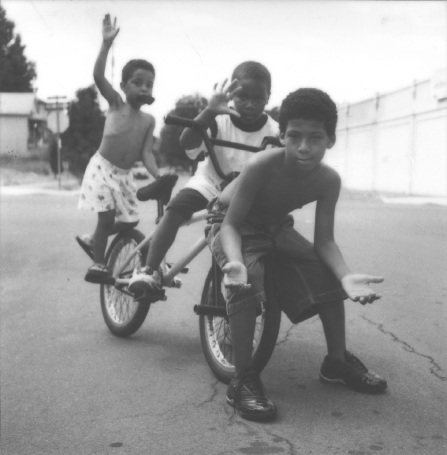The Truth About Some Polaroids
A Not Completely Reliable Chat With Mike Brody
by Katie Byron
This is the Internet’s fault. My interview with the Polaroid Kid, aka Mike Brodie, might as well have been done on Instant Messenger, but it was a Gmail conversation, which in the end seems fitting for an artist who appears disgruntled with, and at the same time reliant on, the Internet for showcasing his talent.
Though he’s been showing work in galleries for the past few months, his websites (ridindirtyface.com; plrds.com) seem to be responsible for most of his exposure. I have never seen a Polaroid Kid print in person, yet I feel well acquainted with his entire portfolio through the World Wide Web.
Before I decided to buckle down and contact him directly, I embarked on an investigation into the Mike Brodie persona. I gathered that he was some sort of mythical character, hopping trains from town to town, stealing film and borrowing a scanner every now and then to get his images online. He obviously had a lot of friends and connections, as I’d often heard his name rattled off at art shows and parties.
I began by speaking only to casual acquaintances, people who barely knew the Polaroid Kid, who could give me a rough idea of what character he exudes. I heard the term “sincere” a lot, coupled with a list of other contacts I should seek for more info on him.
I thought I had a good idea of the type of person he was from these brief descriptions, and felt that I understood him through his stylized photography. I saw him as some delicate flower, wide-eyed and young, full of passion and sincerity. I saw him as a cliché, a peer, and someone I had pinned down. I figured he cared about children and poor people and he had big dreams for society and high anxiety about ever making it as an artist.
Up Close and Personal
After creating an estimated persona for the Polaroid Kid, I decided to finally get in touch; it was time to see how closely the image in my mind matched up to the real thing. I began by asking him questions I felt I already knew the responses to, and was completely shocked by the answers he provided. I wondered if I had gotten in touch with the wrong Mike Brodie, or perhaps his little brother snuck onto his e-mail account to sabotage him.
When asked if he felt emotionally connected with each of his photographs, he remarked, “There are a few in there that make me a little teary eyed, but for the most part no. Also, if you see Jackie aka ‘The Cat Woman’ in Berkeley anywhere, please let her know that I’m trying to track her down!!!”
It was hard for me to believe this, based on his work. The style and delicacy of his shots typically make even the most rugged individual appear beautiful. In most images, the central figure is never far from the viewfinder, and rarely in motion. It comes across as almost calculated, as if the Kid is intending to teach some intricate lesson to the world. When asked what that lesson might be, he simply replied, “Nothing really, I think humans have failed at learning social skills or anything beneficial. Basically it’s all been downhill ever since Jesus croaked.”
So, which of his images did personally affect him? Brodie picks out a Polaroid of a young man he calls Mr. Brontez. “This photo would in turn result in my first homosexual experience. I promised Mr. Brontez that if I photographed him I’d show him my dick, which I did, then he started sucking on it like a popsicle. Then I kissed him and got a cold sore. Needless to say, I’m not a very good fag.”
False Memory Syndrome
By this point, I had gotten used to the revised Mike Brodie persona. The last question I asked him in my first e-mail had to do with his personal life. I already knew all the hearsay anecdotes—bits about him living in an elevator shaft and the like. I knew he had a girlfriend. I was hoping, though, he could give me a bit more insight into his personhood. What he divulged to me was a bit more than I had expected to hear. “Well, when I was eight I got caught masturbating in school, and then my dad caught me humping a stuffed animal one time, but I don’t think that has anything to do with my photography.”
I bit my lip at that response, wondering how I had gathered such a false impression. I really began to sense the problem with my process of constructing an identity based upon artwork and acquaintances. Photos present us with what Siegfried Kracauer describes as “false memory syndrome,” offering only a surface image. Kracauer’s understanding of photography as an inaccurate account of experienced reality still rings true nearly a century after his essay “Photography” was written. Brodie’s Polaroids can’t be expected to expose a truth about his personhood, or about those he chooses to photograph. In his images, the gaze of the viewer almost always meets that of the figure that is posing, heightening a mostly unfounded sense of familiarity and emotional understanding between the two. Brodie’s photos, along with his brief interactions with others, present a projected sense of intimacy, mostly constructed from surface impressions and the viewers’ own imaginations.

Perhaps that is why The Polaroid Kid admits he isn’t emotionally attached to any of his Polaroids. They are not representative of his lived reality. They have become objects, fully removed from his past. They are snapshots that lose meaning and reliability, or rather develop an entirely different meaning, each time he picks them up or scrolls through them on his computer.
“When I view them on the Internet I feel completely disconnected from all of them, like I don’t know how, why, or when I took any of them. I’ve looked at them so much that when I see them now they seem so unreal and fantastic that I don’t remember physically being a part of any of those moments. I could tell you stories about the time and place and people, but it would be all coming from stored memory and not things I remember actually doing. When I physically shuffle through them I’m glad to have collected so many, they all are so imperfect and fading and aging and eventually they’ll evaporate forever but who cares.”
It’s an odd juxtaposition, to show remnants of a dead or dying piece of technology using the Web, offering an unduplicatable, temporal piece of art up to a scanner so that millions can view it any time, day or night, long after the color has faded from the original photo or memory. In this online setting the Polaroid is less of a sacred artifact, a specific marker of time and locality, less something Walter Benjamin might grant “cult value,” because it is available, in non-material form, to anyone who can use the Internet.
But the Polaroid Kid, for the time being, does not seem overly concerned with any of this. “Basically I’m just looking forward to 2012 when my dad gets out of prison and we get stoned, together with all those crazy train hopping Mayans who get derailed, under a flaming ball of terrorist fire!!!”
Perhaps he is a wide-eyed flower for a new generation.
Katie Byron in a visual artist and occasional writer living in Los Angeles.
Photo One: The Cat Woman (Berkeley, CA)
2005
Photo Two: The Polaroid Kids (Portland, OR)
2005
